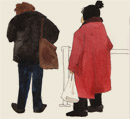
Illustration by Zack Sultan
Neighborhoods are always shifting. Like tectonic plates, their boundaries are constantly fracturing, expanding, abolishing. Yet, they also seem to remain the same. Some core of a neighborhood continues to draw people and even dictate the identity of the people living there.
You can tell you are in one by the type of trash, or the way people dress, or the way residents spend their summers. Walking down the street, you can tell that a neighborhood is moving south or getting closed in on. Chinatown is getting pushed in on from all sides, but it is growing in Queens and Brooklyn. Park Slope is spilling like a rising flood into Sunset Park. Harlem is desperately trying to hold onto itself, but seeing its structures co-opted one by one.
But ultimately they are imaginary places, pulled together by a kind of magnetism, a story. People flock there because they conceive of it as the spot where they will be among others like themselves. It is an act of identity: To be among near-dwellers. “To be a human being means to be on the earth as a mortal. It means to dwell,” said Heidegger. The shifting of a neighborhood’s edges is a battle of narratives. Only the strongest, most relevant will survive. The rest are subjugated to history, like the German village of Yorkeville or the sixth borough that was demolished to make room for more boat traffic. Their traces can be found in the architecture behind the new Starbucks, in abandoned nuclear fallout shelters, or the yellowed newspaper albums of the New York Public Library.
For this edition, our correspondents traced the neighborhoods that exist in the precincts of an island of the mind, a floating borough just off Staten Island. Each place carries a sliver of a story; some are conundrums, others are the extrapolations of a single thought or an overheard fragment.
We traveled as far as Rwanda to see how a series of cities on hills are forced to look at the bare, haunted faces of each other — and to Arizona, where a libertarian lifestyle led to visions of giant vehicles mating in sweltering parking lots and pale citizens unable to speak in a common tongue.
And our resident anthropologist showed in a series of photos that the quickest way to the heart of a neighborhood was in its waste. After all, Prof. Robin Nagle, one of the most perspicacious modern observers of this city said in an article last year:
Assuming there’s still a tourist trade to New York a hundred years from now, people will visit Fresh Kills landfill the way tourists go to the cemeteries in France. It will stand for us as a grand monument, like the Great Wall of China. The lower layers of Fresh Kills are so tightly compacted that there’s no chance for microbes to get in there to eat things, so you have very well preserved hot dogs, for instance, that you assume rot over time. And newspapers and CDs and DVDs, cassette tapes and eight-tracks and videos by the zillion. In 2108, somebody may have the curiosity or foresight to excavate the landfill to learn about the culture that created this vast repository.
A neighborhood need not be a set of streets and avenues: It starts with a single building, perhaps even a hallway, a room, as Emily Nemens shows us in her fives stories. And for those worried about the swift, irrevocable redefinition of their little block in Brooklyn, Seth Ullman presents, re-presents, a philosophy that can be summarized as: go outside.








